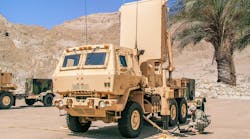Gallium nitride (GaN) semiconductor technology is contributing to the improved performance and extended range of the U.S. Army’s AN/TPQ-53 (Q-53) radar system in its full-rate-production configuration. The Army has awarded Lockheed Martin a contract modification to insert GaN active-device technology into the Q-53 radar system for increased range and coverage in full-rate-production systems. The move to GaN will add transmit power to the system for increased radar illumination and detection range.
“Lockheed Martin is proud the Army is adding Q-53 to our family of fielded GaN based radars,” said Rick Herodes, director of the Q-53 program at Lockheed Martin. “This modification takes advantage of our broad experience with radar production and next generation radar development experience coupled with Lockheed Martin’s continuous investment in GaN and other radar technologies.
This update enables Q-53 mission growth for changing Army needs,” Herodes added. “We realize how critical it is to enhance the capabilities of the Q-53 so it can be responsive to the evolving operational demands and emerging threats our deployed troops face every day.”
The AN/TPQ-53 radar system is a solid-state phased-array radar that is designed to detect and track enemy systems while operating in 360- and 90-deg. modes. It is replacing aging AN/TPQ-36 and AN/TPQ-37 medium-range radars in the Army’s inventory and, compared to those two radar systems, provides greater mobility, greater reliability, and increased supportability, with lower life-cycle costs and reduced crew sizes. The AN/TPQ-53 uses a software-controlled active electronically scanned array (AESA) architecture for its multiple-mission capabilities, including effective identification and tracking of unmanned aerial systems (UASs).

